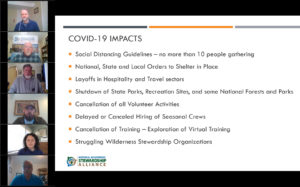by Samantha Haas, Communications Coordinator, Partnership for the National Trails System
Maybe COVID-19 won’t spread throughout the whole country. I think many Americans held onto that hope until March 11, 2020, when the World Health Organization declared the novel coronavirus a global pandemic.
Time seemed to slow that week as the reality of this dire situation, and words such as “social distancing” and “self-quarantine,” began to sink into our psyche. We were bombarded by news updates and social media notifications as events were being postponed or canceled, school districts were closing, and businesses were scrambling to figure out how to retain employees and continue providing services safely so they wouldn’t have to shut their doors.
As gathering indoors was no longer deemed safe, many government and public health officials urged citizens to get outside and use natural resources. Being in nature holds innumerable benefits for our well-being, but several parks, trails, and remote communities were overwhelmed by unanticipated numbers of people—some of whom were traveling great distances to and from the nation’s hotspots for the virus. Overcrowded parking lots and summits unfortunately meant more people were leaving behind trash and potential traces of the disease on surfaces such as picnic tables, privies, and shelters. The need for clear communication and consistent messaging around responsible outdoor use and maintaining good hygiene during a pandemic was not being met, in part because the blueprint for doing so didn’t really exist.

Screenshot from YouTube
The National Wilderness Stewardship Alliance hosted an online town hall conversation, “The Impact of Covid 19 on the Wilderness Stewardship Community,” on April 2, 2020. Panelists represented the U.S. Forest Service, Appalachian Trail Conservancy, and Southern Appalachian Wilderness Stewards. The recording is available at https://bit.ly/356rJGm.
Two days later, Sandi Marra, President and CEO of the Appalachian Trail Conservancy (ATC), organized an online video meeting with national scenic trail nonprofit leaders to discuss the impact of the crisis on their staff, volunteers, members, donors, and trail users (especially in regard to thru-hikers) and begin developing guidance for visitors. Just one month earlier, these Partnership for the National Trails System (PNTS) member organizations had all been together in Washington, D.C. to advocate for national trails funding and other issues during Hike the Hill.
By listening to the ATC’s experience with handling norovirus outbreaks along the trail in past years and sharing their own stories from the field, this virtual network felt supported to craft best practices and broadcast them to their trail communities since many organizations lacked initial guidance from their Federal agency partners.
The following week, in an attempt to keep the broader community apprised of the quickly evolving situation, PNTS launched a webpage to track COVID-19 updates and resources for national scenic and historic trails. That eventually included the disappointing news about the cancellation of the Spring National Trails Workshop, scheduled for May at Ghost Ranch in New Mexico. Realizing that information sharing might not happen in person for quite some time, PNTS also expanded its webinars webpage to become a hub for all trail- and nonprofit-related online learning opportunities from a variety of host organizations.
What became apparent is that no two trails are alike in their responses to COVID-19. While some are trying to discourage all types of trail use and volunteer work, others are encouraging people to safely enjoy or help maintain their local trails. That’s because each trail is unique, attracting different types of users and crossing several jurisdictions that can change their rules or “stay-at-home” orders without much notice.
Our 30 national scenic and historic trails cross all 50 States and D.C., more than 100 Bureau of Land Management areas, over 230 major urban areas and Trail Towns, and nearly 400 national parks, forests, wildlife refuges, and nationally designated wilderness areas—each with their own guidelines. And unlike a park that can try to prohibit people from entering in vehicles by closing a gate, trails can be accessed from multiple points by foot making them very difficult to close or monitor.
The disparity we’re seeing between trail responses does not equate to division. Yes, there are challenges we need to address, but growing pains are expected as our diverse National Trails System enters into the next 50 years of public-private partnerships.
We have persevered through temporary government shutdowns before, and we are already finding creative ways to adapt during COVID-19 lockdowns now. Let’s learn from these experiences so that when it is finally safe to resume trail activities (and if or when it’s necessary to pause them again), we remember the value of collaborating within and beyond the trails community to sustain our remarkable natural, cultural, scenic, and historic resources. We are all in this together.
PNTS is updating these pages with COVID-19 related trail resources and webinars to the best of its ability:
- www.pnts.org/new/covid-19-updates-for-national-scenic-and-historic-trails/
- www.pnts.org/new/webinars/
Unless otherwise indicated, all material in Pathways Across America is public domain. All views expressed herein are perspectives of individuals working on behalf of the National Trails System and do not necessarily represent the viewpoint of the Federal agencies.